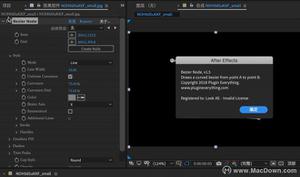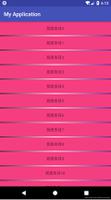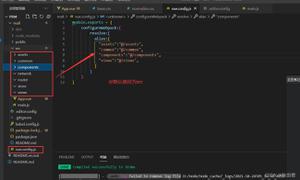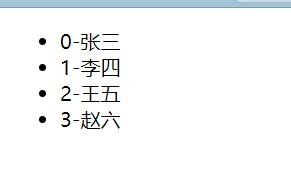vue--常用指令和事件修饰符

安装
官网:https://cn.vuejs.org/
下载:https://cn.vuejs.org/v2/guide/installation.html
直接通过script在head标签里导入就可以了
<script src="../static/vue.min.js"></script>
或者通过CDN的方式直接引用
<script src="https://cdn.jsdelivr.net/npm/vue"></script>
模版语法
大家都知道django里的模版语法是{{ }},事情总是巧合的,Vue里的模版语法也是{{ }}
<!DOCTYPE html><html lang="zh-CN">
<head>
<meta http-equiv="content-Type" charset="UTF-8">
<title>Title</title>
<!-- 引用vue-->
<script src="../static/vue.min.js"></script>
</head>
<body>
<div id="app">
<!-- 模版语法-->
<h1>{{ msg }}</h1>
</div>
<script>
// 实例化对象
new Vue({
el:"#app", // 固定写法el,查找的元素
data:{ // 固定写法,是个object,里面放的数据
msg:"hello vue" // 数据,前面的为模版里放的变量名,后面为对应的数据
}
})
</script>
</body>
</html>
上面使用的是vue的方法查找id为app的属性,并将里面的文本替换为“hello vue”
指令
指令就是帮我们渲染数据的,语法:v-指令
上面的代码我们可以用指令v-text来实现
v-text
v-text相当于innerText,v-html相当于innerHTML,其实和上面的模版语法效果一样
data中是一个函数,函数中return一个对象,可以是空对象,但不能return
<!DOCTYPE html><html lang="zh-CN">
<head>
<meta http-equiv="content-Type" charset="UTF-8">
<title>Title</title>
<!-- 引用vue-->
<script src="../static/vue.min.js"></script>
</head>
<body>
<div id="app">
<!-- 模版语法-->
<h1 v-text="msg"></h1> <!-- 写在标签里面-->
</div>
<script>
// 实例化对象
new Vue({
el:"#app", // 固定写法el,查找的元素
data(){
return {
msg:"<h2>hello vue</h2>"
}
}
})
</script>
</body>
</html>
上面的将msg的内容原样显示在了页面上,没有当成标签渲染后显示,如果要渲染后显示在页面上,
就要用到v-html了
v-html
v-text相当于innerText,v-html相当于innerHTML
<!DOCTYPE html><html lang="zh-CN">
<head>
<meta http-equiv="content-Type" charset="UTF-8">
<title>Title</title>
<!-- 引用vue-->
<script src="../static/vue.min.js"></script>
</head>
<body>
<div id="app">
<!-- 模版语法-->
<h1 v-html="msg"></h1> <!-- 写在标签里面-->
</div>
<script>
// 实例化对象
new Vue({
el:"#app", // 固定写法el,查找的元素
data(){ <!--data中是一个函数,函数中return一个对象,可以是空对象,但不能return-->
return {
msg:"<h2>hello vue</h2>"
}
}
})
</script>
</body>
</html>
v-for
v-for可以迭代数组和迭代对象
v-for迭代数组
- 语法:v-for="(alias,index) in array"
- 说明:alias是数组迭代的别名,index数组索引值,从0开始(可选,如果有就要加小括号)
v-for迭代对象的属性
- 语法: v-for=“(value,key,index) in object”
- 说明:value每个对象的属性值,key为属性名(可选),index为索引(可选)
<!DOCTYPE html><html lang="en">
<head>
<meta charset="UTF-8">
<meta name="viewport" content="width=device-width, initial-scale=1.0">
<meta http-equiv="X-UA-Compatible" content="ie=edge">
<title>Document</title>
</head>
<body>
<div id="app">
<h3>1.迭代数组</h3>
<ul>
<!-- e 代表的是emps数组的别名,index 数组下标,从0开始 的
注意:使用 key 特殊属性, 它会基于 key 的变化重新排列元素顺序,并且会移除 key 不存在的元素
可以使用of或者in作为分隔符
-->
<li v-for="(e, index) of emps" :key="index">
编号:{{index+1}},姓名: {{e.name}} , 工资 :{{e.salary}}
</li>
</ul>
<h3>2.迭代对象</h3>
<ul>
<!-- value对应是的对象的属性值,key就是对象的属性名,index索引值 -->
<li v-for="(value, key, index) in person">
第{{index+1}}个属性为:{{key}} = {{value}}
</li>
</ul>
</div>
<script src="./node_modules/vue/dist/vue.js"></script>
<script>
new Vue({
el: '#app',
data: {
emps: [
{name: '马云', salary: '20000'},
{name: '马化腾', salary: '18000'},
{name: '东哥', salary: '13000'}
],
person: {
name: '小梦',
age: 18
}
}
})
</script>
</body>
</html>
结果:
列表
<!DOCTYPE html><html lang="zh-CN">
<head>
<meta http-equiv="content-Type" charset="UTF-8">
<title>Title</title>
<script src="../static/vue.min.js"></script>
</head>
<body>
<div id="app">
<ul>
<li v-for="student in students">{{student}}</li>
</ul>
</div>
<script>
new Vue({
el:"#app",
data:{
students: ["张三","李四","王五"]
}
})
</script>
</body>
</html>
字典
<!DOCTYPE html><html lang="zh-CN">
<head>
<meta http-equiv="content-Type" charset="UTF-8">
<title>Title</title>
<script src="../static/vue.min.js"></script>
</head>
<body>
<div id="app">
<ul>
<li v-for="student in students">姓名:{{student.name}},年龄:{{student.age}},职业:{{student.job}}</li>
</ul>
</div>
<script>
new Vue({
el:"#app",
data:{
students: [
{
name:"张三",
age: 25,
job:"test"
},
{
name:"李四",
age: 56,
job:"IT"
},
{
name:"王五",
age: 85,
job:"dev"
}
]
}})
</script>
</body>
</html>
v-if
v-if是否渲染当前元素,v-show 与v-if类似,只是元素始终会被渲染并保留在DOM中,只是简单切换元素的CSS属性display来显示或隐藏
案例
<!DOCTYPE html><html lang="en">
<head>
<meta charset="UTF-8">
<meta name="viewport" content="width=device-width, initial-scale=1.0">
<meta http-equiv="X-UA-Compatible" content="ie=edge">
<title>Document</title>
<script src="./node_modules/vue/dist/vue.js"></script>
<style>
.box{
height: 200px;
width: 200px;
background: red;
}
</style>
</head>
<body>
<div id="app">
<input v-model="seen" type="checkbox" name="" id="">勾选后显示红色小块
<div v-if="seen" class="box"> </div>
<p v-else>红色小块隐藏了</p>
</div>
<script>
new Vue({
el: "#app",
data: {
seen: false,
}
})
</script>
</body>
</html>
v-show
<!DOCTYPE html><html lang="zh-CN">
<head>
<meta http-equiv="content-Type" charset="UTF-8">
<title>Title</title>
<!-- 引用vue-->
<script src="../static/vue.min.js"></script>
<style>
.box {
width: 200px;
height: 200px;
background-color: red;
}
.box2 {
width: 200px;
height: 200px;
background-color: green;
}
</style>
</head>
<body>
<div id="content">
<button v-on:click='handlerClick'>隐藏</button>
<div class="box" v-show='isShow'></div>
</div>
<script>
//数据驱动视图
new Vue({
el: '#content',
data() {
//data中是一个函数 函数中return一个对象,可以是空对象 但不能不return
return {
msg: "<h2>alex</h2>",
num: 1,
isShow: true
}
},
methods: {
handlerClick() {
//数据驱动
console.log(this);
this.isShow = !this.isShow; //取反
}
}
})
</script>
</body>
</html>
当第一次点击隐藏按钮的时候,isShow变为false,隐藏红色的框(加了个样式,display: none;)。当第二次点击的时候,因为isShow为fasle,所以取反之后变为true,显示红色的框
v-show要使用methods里的函数
当isshow为false的时候,页面的html是通过display:none,把内容隐藏了
切换性能:
v-show的切换性能高一些,display: none, v-if的切换是通过append
加载性能:
v-show的慢,v-if的快
v-on
点击事件,要写在methods里面
事件处理方法
- 完整格式:v-on:事件名=“函数名” 或 v-on:事件名="函数名(参数...)"
- 缩写格式:@事件名="函数名" 或 @事件名="函数名(参数)" 注意@后面没有:
- event:函数中的默认形参,代表原生DOM事件,当调用的函数有多个参数传入时,需要使用原生DOM事件,则通过$event作为实参传入,用于监听DOM事件
<!DOCTYPE html><html lang="en">
<head>
<meta charset="UTF-8">
<meta name="viewport" content="width=device-width, initial-scale=1.0">
<meta http-equiv="X-UA-Compatible" content="ie=edge">
<title>Document</title>
</head>
<body>
<div id="app">
<h3>1. 事件处理方法 v-on 或 @</h3>
<button v-on:click="say">Say {{msg}}</button>
<!-- $event代表的是原生 的Dom事件 -->
<button @click="warn('hello', $event)">Warn</button>
</div>
<script src="./node_modules/vue/dist/vue.js"></script>
<script>
new Vue({
el: '#app',
data: {
msg: 'Hello World!!',
num: 0
},
methods: { //定义事件处理函数
say: function (event) {
// event代表的是Dom原生事件, Vue.js它会自动 的将它传入进来,
alert(this.msg)
alert(event.target.innerHTML)
},
warn: function (name, event) {
//如果说函数有多个参数,而双需要使用原生事件,则需要使用 $event 作为 参数传入
alert(name + ',' + event.target.tagName)
}
}
})
</script>
</body>
</html>
事件修饰符
- .stop阻止单击事件继续传播
- .prevent阻止事件默认行为
- .once点击事件只会触发一次
<!DOCTYPE html><html lang="en">
<head>
<meta charset="UTF-8">
<meta name="viewport" content="width=device-width, initial-scale=1.0">
<meta http-equiv="X-UA-Compatible" content="ie=edge">
<title>Document</title>
</head>
<body>
<div id="app">
<h3>2. 事件修饰符</h3>
<!-- 2.1 防止单击事件继续传播 -->
<div @click="todo"> <!-- 点击doThis之后还会触发todo事件 -->
<button @click="doThis">单击事件会继续传播</button>
</div>
<br>
<div @click="todo">
<!-- .stop作用:是阻止事件的传播,点击doThis之后不会触发todo事件 -->
<button @click.stop="doThis">阻止单击事件会继续传播</button>
</div>
<br>
<!-- 2.2 阻止事件的默认行为,不加prevent会跳转到百度 -->
<a href="http://www.baidu.com" @click.prevent="doStop">百度</a>
<!-- 2.3 点击事件只会触发一次 -->
<button @click.once="doOnly">点击事件只会触发一次:{{num}}</button>
</div>
<script src="./node_modules/vue/dist/vue.js"></script>
<script>
new Vue({
el: '#app',
data: {
num: 0
},
methods: { //定义事件处理函数
doThis: function () {
alert('doThis....')
},
todo: function () {
alert('todo....')
},
doStop: function () {
alert('doStop...href默认行为已经被阻止')
},
doOnly: function () {
this.num ++
}
},
})
</script>
</body>
</html>
按键修饰符
- 格式: v-on:keyup.按键名 或 @keyup.按键名
- 常用按键名
- .enter .tab .delete .esc .space .up .down
<!DOCTYPE html><html lang="en">
<head>
<meta charset="UTF-8">
<meta name="viewport" content="width=device-width, initial-scale=1.0">
<meta http-equiv="X-UA-Compatible" content="ie=edge">
<title>Document</title>
</head>
<body>
<div id="app">
<h3>按键修饰符或按键码</h3>
<!-- 回车键可以用做提交表单数据,比如搜索框 -->
<input type="text" @keyup.enter="keyEnter">
<input type="text" @keyup.space="keySpace">
<input type="text" @keyup.13="keyCode">
</div>
<script src="./node_modules/vue/dist/vue.js"></script>
<script>
new Vue({
el: '#app',
methods: { //定义事件处理函数
keyEnter: function () {
alert('当前按的是回车键')
},
keySpace: function() {
alert('当前按的是空格键')
},
keyCode: function () {
alert('按的是13')
}
},
})
</script>
</body>
</html>
例子二
<!DOCTYPE html><html lang="zh-CN">
<head>
<meta http-equiv="content-Type" charset="UTF-8">
<title>Title</title>
<script src="../static/vue.min.js"></script>
<style>
.active{
color: red;
}
</style>
</head>
<body>
<div id="app">
<h1 :class="{active: isActive}">钢铁侠</h1> <!-- 添加class属性为active -->
<button v-on:click="ChangeColor">点我让钢铁侠变红</button>
</div>
<script>
new Vue({
el:"#app",
data:{
isActive: false
},
methods:{
ChangeColor:function () {
this.isActive = !this.isActive; // 取反
},
}
}
)
</script>
</body>
</html>
v-bind
通过class列表和style指定样式是数据绑定的一个常见需求,他们都是元素的属性,都用v-bind处理,其中表达式结果的类型可以是:字符串,对象或数组
语法格式
- v-bind:class="表达式" 或 :class="表达式"
class的表达式可以为:
- 字符串 :class="activeClass"
- 对象 :class="{active:isActive,error:hasError}"
- 数组 :class="['active','error']" 注意要加上单引号,不然获取的是data中的值
style的表达式一般为对象
- :style="{color:activeColor,fontSize+'px'}"
- 注意:对象中的value值activeColor和fontSize是data中的属性
例子一:
<!DOCTYPE html><html lang="en">
<head>
<meta charset="UTF-8">
<meta name="viewport" content="width=device-width, initial-scale=1.0">
<meta http-equiv="X-UA-Compatible" content="ie=edge">
<title>Document</title>
<script src="./node_modules/vue/dist/vue.js"></script>
<style>
.active{
color:green;
}
.delete{
background: red;
}
.error{
font-size: 35px;
}
</style>
</head>
<body>
<div id="app">
<h3>Class绑定,v-bind:class 或者 :class</h3>
<!-- <p class="active">字符串表达式</p> -->
<p v-bind:class="activeClass">字符串表达式</p>
<!-- key值是样式名,value是data中绑定的属性 -->
<!-- 当isDelete为true的时候,delete就会进行渲染 -->
<p :class={delete:isDelete,error:hasError}> 对象表达式</p>
<p :class="['active','error']">数组表达式</p>
<h3>Style绑定,v-bind:style 或 :style</h3>
<p :style="{color: activeColor, fontSize: fontSize + 'px'}">Style绑定</p>
</div>
<script>
new Vue({
el: "#app",
data: {
activeClass: 'active',
isDelete: false,
hasError: true,
activeColor: 'red',
fontSize: 100
}
})
</script>
</body>
</html>
例子二:
<!DOCTYPE html><html lang="zh-CN">
<head>
<meta http-equiv="content-Type" charset="UTF-8">
<title>Title</title>
<!-- 引用vue-->
<script src="../static/vue.min.js"></script>
<style>
.box {
width: 200px;
height: 200px;
background-color: red;
}
.active{
background-color: green;
}
</style>
</head>
<body>
<div id="app">
<button v-on:click = 'handlerChange'>切换颜色</button>
<!--v-bind 标签中所有的属性 img标签src alt,a标签的href title id class-->
<img v-bind:src="imgSrc" v-bind:alt="msg">
<div class="box" v-bind:class = '{active:isActive}'></div>
</div>
<script>
new Vue({
el: '#app',
data() {
return {
imgSrc:'./1.jpg',
msg:'美女',
isActive:true
}
},
methods:{
handlerChange(){
this.isActive = !this.isActive;
},
}
})
</script>
</body>
</html>
<div class="box" v-bind:class = '{active:isActive}'></div>
div原来有一个class属性,值只有一个box,通过v-bind绑定了一个属性active,isActive为true时把active添加到class里,为false时不添加
<button v-on:click = 'handlerChange'>切换颜色</button>
绑定了一个v-on的click事件,当第一次点击按钮时,去methods里找handlerChange,因为刚开始isActive为true(data里),点击后取反为false,
这时data里的也为false,所以没有active属性
v-on和v-bind的简写
v-bind可以简写为 : v-on可以简写为@
<!DOCTYPE html><html lang="zh-CN">
<head>
<meta http-equiv="content-Type" charset="UTF-8">
<title>Title</title>
<!-- 引用vue-->
<script src="../static/vue.min.js"></script>
<style>
.box {
width: 200px;
height: 200px;
background-color: red;
}
.active{
background-color: green;
}
</style>
</head>
<body>
<div id="app">
<button @mouseenter = 'handlerChange' @mouseleave = 'handlerLeave'>切换颜色</button>
<!--v-bind 标签中所有的属性 img标签src alt,a标签的href title id class-->
<img :src="imgSrc" :alt="msg">
<div class="box" :class = '{active:isActive}'></div>
</div>
<script>
// v-bind和v-on的简便写法 : @
new Vue({
el: '#app',
data() {
return {
imgSrc:'./1.jpg',
msg:'美女',
isActive:true
}
},
methods:{
handlerChange(){
this.isActive = false;
},
handlerLeave(){
this.isActive = true;
}
}
})
</script>
</body>
</html>
v-model
双向绑定,当用户输入的时候,改变原来的值,只能应用在像input,textare,select之类的标签
v-model也叫双向数据绑定
例子一:
<!DOCTYPE html><html lang="en">
<head>
<meta charset="UTF-8">
<meta name="viewport" content="width=device-width, initial-scale=1.0">
<meta http-equiv="X-UA-Compatible" content="ie=edge">
<title>Document</title>
<script src="./node_modules/vue/dist/vue.js"></script>
</head>
<body>
<div id="demo">
<!-- @submit.prevent 阻止事件的默认行为,当前阻止的是action行为 -->
<form action="#" @submit.prevent="submitForm">
姓名(文本):<input type="text" v-model="name">
<br><br>
性别(单选按钮):
<input name="sex" type="radio" value="1" v-model="sex"/>男
<input name="sex" type="radio" value="0" v-model="sex"/>女
<br><br>
技能(多选框):
<input type="checkbox" name="skills" value="java" v-model="skills">Java开发
<input type="checkbox" name="skills" value="vue" v-model="skills">Vue.js开发
<input type="checkbox" name="skills" value="python" v-model="skills">Python开发
<br><br>
城市(下拉框):
<!-- 绑定在select上才会默认选中 -->
<select name="citys" v-model="city">
<option v-for="c in citys" :value="c.code">
{{c.name}}
</option>
</select>
<br><br>
说明(多行文本):<textarea cols="30" rows="5" v-model="desc"></textarea>
<br><br>
<button type="submit" >提交</button>
</form>
</div>
<script>
new Vue({
el: '#demo',
data: {
name: '',
sex: '1', //默认选中的是 男
skills: ['vue', 'python'], //默认选中 Vue.js开发 、Python开发
citys: [
{code: 'bj', name: '北京'},
{code: 'sh', name: '上海'},
{code: 'gz', name: '广州'}
],
city: 'sh', // 默认选中的城市:上海
desc: ''
},
methods: {
submitForm: function () { //处理提交表单
//发送ajax异步处理
alert(this.name + ', ' + this.sex + ', ' + this.skills + ', ' + this.city + ', ' + this.desc)
}
}
})
</script>
</body>
</html>
例子二:
<!DOCTYPE html><html lang="en">
<head>
<meta charset="UTF-8">
<meta name="viewport" content="width=device-width, initial-scale=1.0">
<meta http-equiv="X-UA-Compatible" content="ie=edge">
<title>Document</title>
<script src="./node_modules/vue/dist/vue.js"></script>
</head>
<body>
<div id="app">
<!-- {{}}用于标签体内显示数据 -->
hello,{{ msg }}
<br>
<!-- v-model进行数据的双向绑定 -->
<input type="text" v-model="msg">
</div>
<script >
new Vue({
el: "#app", //指定被Vue管理的入口, 值为选择器, 不可以指定body或者是html
data: { // 用于初始化数据,在Vue实例管理的Dom节点下,可通过模板语法来引用
msg: "vue.js"
}
})
</script>
</body>
</html>
会把msg的信息显示在输入框和div标签里,更改输入框里的数据,div里的也会跟着改,所以叫双向数据绑定
计算属性
computed 选项定义计算属性
计算属性 类似于 methods 选项中定义的函数
- 计算属性 会进行缓存,只在相关响应式依赖发生改变时它们才会重新求值。
- 函数 每次都会执行函数体进行计算。
输入数学与英语分数,采用 methods 与 computed 分别计算出总得分
<!DOCTYPE html><html lang="en">
<head>
<meta charset="UTF-8">
<meta name="viewport" content="width=device-width, initial-scale=1.0">
<meta http-equiv="X-UA-Compatible" content="ie=edge">
<title>Document</title>
</head>
<body>
<div id="app">
数学:<input type="text" v-model="mathScore">
英语:<input type="text" v-model="englishScore"><br>
<!-- v-model调用函数时,不要少了小括号 -->
总得分(函数-单向绑定):<input type="text" v-model="sumScore()"><br>
<!-- 绑定计算属性后面不加上小括号 -->
总得分(计算属性-单向绑定):<input type="text" v-model="sumScore1"><br>
总得分(计算属性-双向绑定):<input type="text" v-model="sumScore2">
</div>
<script src="./node_modules/vue/dist/vue.js"></script>
<script>
/*
1. 函数没有缓存,每次都会被调用
2. 计算属性有缓存 ,只有当计算属性体内的属性值被更改之后才会被调用,不然不会被调用
3. 函数只支持单向
4. 计算属性默认情况下:只有getter函数,而没有setter函数,所以只支持单向
如果你要进行双向,则需要自定义setter函数
*/
var vm = new Vue({
el: '#app',
data: {
mathScore: 80,
englishScore: 90,
},
methods: {
sumScore: function () { //100
console.log('sumScore函数被调用')
// this 指向的就是 vm 实例 , 减0是为了字符串转为数字运算
return (this.mathScore-0) + (this.englishScore-0)
}
},
computed: { //定义计算属性选项
//这个是单向绑定,默认只有getter方法
sumScore1: function () { //计算属性有缓存,如果计算属性体内的属性值没有发生改变,则不会重新计算,只有发生改变 的时候才会重新计算
console.log('sumScore1计算属性被调用')
return (this.mathScore-0) + (this.englishScore-0)
},
sumScore2: { //有了setter和getter之后就可以进行双向绑定
//获取数据
get: function() {
console.log('sumScore2.get被调用')
return (this.mathScore-0) + (this.englishScore-0)
},
//设置数据, 当 sumScore2 计算属性更新之后 ,则会调用set方法
set: function(newValue) { // newVulue 是 sumScore2 更新之后的新值
console.log('sumScore2.set被调用')
var avgScore = newValue / 2
this.mathScore = avgScore
this.englishScore = avgScore
}
}
},
})
</script>
</body>
</html>
computed 选项内的计算属性默认是 getter 函数,所以上面只支持单向绑定,当修改数学和英语的数据才会更新总分,而修改总分不会更新数据和英语
如果是用户输入的,那会直接拼接起来,因为用户输入的数字也会被当成字符串。可以使用number来解决这个问题
<td><input type="text" v-model.number="python" /></td><td><input type="text" v-model.number="vue"></td>
<td><input type="text" v-model.number="selenium"></td>
上面当我们输入时,vue会监听我们输入的内容,这样大大降低了性能,我们可以使用lazy,当失去光标的时候再执行
<td><input type="text" v-model.number.lazy="python" /></td><td><input type="text" v-model.number.lazy="vue"></td>
<td><input type="text" v-model.number.lazy="selenium"></td>
实战
图片切换(图片放自己的路径)
<!DOCTYPE html><html lang="zh-CN">
<head>
<meta http-equiv="content-Type" charset="UTF-8">
<title>Title</title>
<!-- 引用vue-->
<script src="../static/vue.min.js"></script>
</head>
<body>
<div id="app">
<img :src="images[currenIndex].imageSrc" alt=""><!-- 按索引取图片-->
<br>
<button @click="preImage">上一张</button> <!-- 绑定点击事件-->
<button @click="nextImage">下一张</button>
</div>
<script>
new Vue({
el:"#app",
data(){
return{
images:[
{id:1,imageSrc:"../image/1.jpg"},
{id:2,imageSrc:"../image/2.jpg"},
{id:3,imageSrc:"../image/3.jpg"},
],
currenIndex:0
}
},
methods:{ <!-- 点击下一张按钮时调用这个方法-->
nextImage(){
this.currenIndex++;
if (this.currenIndex == 3){
this.currenIndex=0;
}
},
preImage(){
if (this.currenIndex == 0) {
this.currenIndex=3;
}
this.currenIndex--;
}
},
created(){ //组件,ajax
setInterval(()=>{
this.currenIndex++;
if (this.currenIndex == 3){
this.currenIndex=0;
}
},2000)
}
})
</script>
</body>
</html>
以上是 vue--常用指令和事件修饰符 的全部内容, 来源链接: utcz.com/z/380311.html









